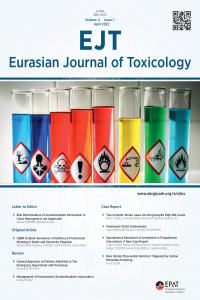Demographic Characteristics of Patients Applied to The Emergency Service with Drug Intoxications
ilaç intoksikasyonu, demografik, zehirlenme
Demographic Characteristics of Patients Applied to The Emergency Service with Drug Intoxications
drug intoxications, demographic, poisoning,
___
- 1. Pekdemir M, Kavalcı C, Durukan P, Yıldız M. Acil servisimize başvuran zehirlenme olgularının değerlendirilmesi. Acil Tıp Dergisi. 2002;2(2):36-40.
- 2. Wax PM. History. In: Goldfrank LR, Flomenbaum NE. Toxicologic Emergencies (Ed 6th) New York, McGrawHill 1998:1-14.
- 3. Özcan N, İkincioğulları D. Ulusal zehir danışma merkezi 2008 yılı çalışma raporu özeti. Türk Hijyen ve Deneysel Biyoloji Dergisi. 2009;66(Supp: ER-3):29-58.
- 4. Schaper A. Präklinisches Management von Vergiftungen–Bedeutung des Giftnotrufs für den Rettungsdienst. Intensiv-und Notfallbehandlung. 2010;35(4):178-85.
- 5. Schaper A, Ceschi A, Deters M, Kaiser G. Of pills, plants, and paraquat: The relevance of poison centers in emergency medicine. European journal of internal medicine. 2013;24(2):104-9.
- 6. Mert E, Bilgin NG. Demographical, aetiological and clinical characteristics of poisonings in Mersin, Turkey. Human & experimental toxicology. 2006;25(4):217-23.
- 7. Karakaya A, Vural N. Acute poisoning admissions in one of the hospitals in Ankara. Human toxicology. 1985;4(3):323-6.
- 8. Özayar E, Degerli S, Güleç H, Sahin S, Dereli N. Yogun Bakima Kabul Edilen Zehirlenme Olgularinin Retrospektif Analizi/Retrospective Analysis of Intoxication Cases in the ICU. Dahili ve Cerrahi Bilimler Yogun Bakim Dergisi. 2011;2(3):59.
- 9. Özköse Z, Ayoĝlu F. Etiological and demographical characteristics of acute adult poisoning in Ankara, Turkey. Human & experimental toxicology. 1999;18(10):614-8.
- 10. Akköse Ş, Fedakar R, Bulut M, Çebiçci H. Zehirlenme olgularının beş yıllık analizi. Acil Tıp Dergisi. 2003;3(1):8-10.
- 11. Kekeç Z, Sözüer E, Duymaz H, Ökkan S. Acil servise başvuran çoklu ilaç zehirlenmelerinin yedi yıllık analizi. Türkiye Acil Tıp Dergisi. 2005;5(2):69-72.
- 12. Tüfek D, Taşdemir BB, Sivaci R. Yoğun Bakım Ünitesinde İzlenen İntoksikasyon Hastalarının Retrospektif İncelemesi. Türk Yogun Bakim Dergisi. 2017;15(2):67.
- 13. Buckley NA, Dawson A, Whyte I, Hazell P, Meza A, Brie H. An analysis of age and gender influences on the relative risk for suicide and psychotropic drug self‐poisoning. Acta Psychiatrica Scandinavica. 1996;93(3):168-71.
- 14. ERAY O, TUNÇOK Y. Zehirlenen Hastaya Yaklaşım: Akut Zehirlenmelerde Hastaya Acil Yaklaşımda Yenilikler. Türkiye Klinikleri Farmakoloji-Özel Konular. 2003;1(1):36-40.
- 15. Avınca Ö, Şen A, Karakoç Y, Damar Ö, Taş M. ZEHİRLENmELER: NEDEN SUİSİT, NEDEN KADINLAR? JNBS. 2019:83.
- 16. Stenbacka M, Samuelsson M, Nordström P, Jokinen J. Suicide risk in young men and women after substance intoxication. Archives of suicide research. 2018;22(2):254-62.
- Yayın Aralığı: Yılda 3 Sayı
- Başlangıç: 2019
- Yayıncı: Acil Tıp Uzmanları Derneği
Can YILDIZ, Ramazan KÖYLÜ, Yahya Kemal GÜNAYDIN, Belgin AKILLI, Göknur YILDIZ, Özge TURGAY YILDIRIM
Metotreksat Kullanıma Bağlı Pansitopeni
Fatih GÜNEYSU, Ayhan SARITAŞ, Ensar DURMUŞ, Semih GÜNEYSU
Nadir Görülen Bir İntoksikasyon Vakası: Izoniazid İntoksikasyonu
Necmi BAYKAN, Mustafa ALPASLAN, Polat DURUKAN
Demographic Characteristics of Patients Applied to The Emergency Service with Drug Intoxications
Kasım TURGUT, Ali GÜR, Abdullah Keyfo KAMA, Mehmet Gökhan TURTAY, Hakan OĞUZTÜRK
Siklosporin Kullanımının Nadir Bir Komplikasyonu:Nöbet
Hatice Şeyma AKÇA, Hayrullah YÖNAK, Murat BALCIOĞLU, Serkan Emre EROĞLU
Bahar KESKİN ÇELİK, Meryem BETOS KOÇAK, Bora ÇEKMEN, Turgut DOLANBAY, Sinem DOĞRUYOL
